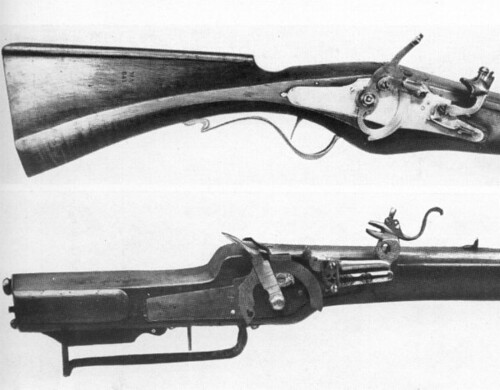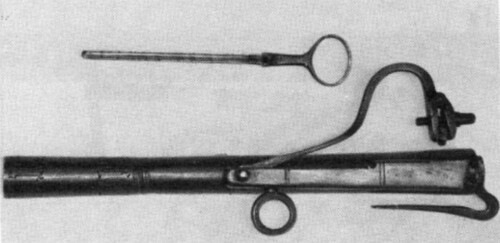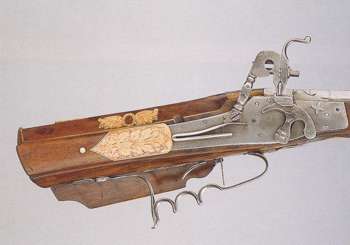Another unusual lock, although not strictly in the catergory of wheellocks can be mentioned here as there is at least, a resemblance between the two. This was the segment lock, in which the wheel was replaced by a pivoted segment of steel. No key was necessary with this lock as the segment was simply pulled back until it was held against the pressure of the mainspring by the sear. The mainspring acted on a tumbler fastened to the cock-spindle inside the lock in the manner of a flintlock. A cock, similar to that of a wheellock was employed to hold the pyrites against the serrated edge of the segment. Thierbach illustrates a combined segment lock and matchlock in which the cock is connected to the segment by a slotted link, and acts as a handle to pull back the segment for cocking. The invention of the segment lock is attributed by Antonio Petrini in his "Arte Fabrile" of 1642 to the Italian Gunmaker Rafalle Verdiani (c1580-1630). This gunmaker worked for the Medici in Florence and must have been a mechanic of no mean ability; but only one example of his lock is known. It is on a gun in the Tower of london Armouries and is signed and dated inside RAF. VERD. 1619"
"Another group of locks which come into the scope of this chapter were the "rasp" locks in which a straight metal rasp is pulled out, or moved longitudinally against a piece of pyrites or flint. They are based on an early pistol in the Historisches Museum, Dresden which, because of its traditional association with (the mythical) Berthod Schwarz, is known as the "Monks Gun". It consists of an iron barrel, just under a foot long, with a long narrow box rivetted on one side. Through this box runs a steel rasp of rectangular section, with longitudinal grooving on its upper face, terminating in a large ring handle. At the front end of the box, a curved cock with hinged jaws, similar to those of Leonardo's wheelock drawings, is pivotted, so that when it is brought down the pyrites rests on the rasp where it runs through the priming pan. The gun is fired by a quick backwards pull of the rasp handle. The design of the cock and the use of gothic lettering suggest this lock is of the first quarter if the 16th century. Other examples of the rasp lock, but of a latter date are illustrated by Thierbach. They include a brass cannon lock in the Zeughaus, Berlin with an action similar to that of the Monks Gun, and a gun lock from the Sigmaringen Museum actuated by a spiral spring"
Howard L Blackmore, "Guns of the World"
(pictures to follow)
"Another group of locks which come into the scope of this chapter were the "rasp" locks in which a straight metal rasp is pulled out, or moved longitudinally against a piece of pyrites or flint. They are based on an early pistol in the Historisches Museum, Dresden which, because of its traditional association with (the mythical) Berthod Schwarz, is known as the "Monks Gun". It consists of an iron barrel, just under a foot long, with a long narrow box rivetted on one side. Through this box runs a steel rasp of rectangular section, with longitudinal grooving on its upper face, terminating in a large ring handle. At the front end of the box, a curved cock with hinged jaws, similar to those of Leonardo's wheelock drawings, is pivotted, so that when it is brought down the pyrites rests on the rasp where it runs through the priming pan. The gun is fired by a quick backwards pull of the rasp handle. The design of the cock and the use of gothic lettering suggest this lock is of the first quarter if the 16th century. Other examples of the rasp lock, but of a latter date are illustrated by Thierbach. They include a brass cannon lock in the Zeughaus, Berlin with an action similar to that of the Monks Gun, and a gun lock from the Sigmaringen Museum actuated by a spiral spring"
Howard L Blackmore, "Guns of the World"
(pictures to follow)







